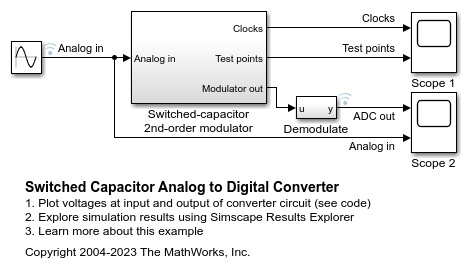Fully Differential Op-Amp
Operational amplifier with fully differential output, that is, not referenced to ground
Libraries:
Simscape /
Electrical /
Integrated Circuits
Description
The Fully Differential Op-Amp block models a fully differential operational amplifier. Differential signal transmission is better than single-ended transmission due to reduced susceptibility to external noise sources. Applications include data acquisition where inputs are differential, for example, sigma-delta converters.
The following diagram shows the internal representation of the amplifier.

Parameters for the circuit components are derived from the block parameters that you
provide. The gain of the two voltage-controlled voltage sources (VCVS1 and VCVS2) is set
to half of the differential gain value. Similarly the slew rate of each of the voltage
sources is set to half of the differential maximum slew rate value. The voltages of the
two output ports Vout+ and Vout- are both limited
to be within the minimum and maximum output voltages that you specify.
The output voltage for zero differential input voltage is controlled by the
common-mode port, cm. If no current is drawn from the
cm port by the external circuit, then the output voltage is set
to be the average of the positive and negative supply voltages by the resistor ladder of
R3a and R3b. Note that the negative supply voltage can be zero, which corresponds to
operation when a split supply is not available. The values for the minimum and maximum
output voltages that you provide must be consistent with the values for the supply
voltages that you provide. So, for example, the maximum output high voltage will be less
than the positive supply voltage, the difference corresponding to the number of p-n
junction voltage drops in the circuit.
Examples
Assumptions and Limitations
This block provides a behavioral model of a fully differential operational amplifier. It does not represent nonlinear effects, such as variation in gain with output voltage amplitude, and the nonlinear nature of the output voltage-current relationship for large load currents.
.
Ports
Conserving
Parameters
Extended Capabilities
Version History
Introduced in R2012a

